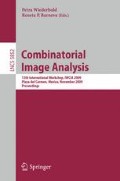Abstract
Improving or generalizing lane detection solutions on curved roads with possibly broken lane marks is still a challenging task. This paper proposes a concept of a (virtual) corridor for modeling the space an ego-vehicle is able to drive through, using available (but often incomplete, e.g., due to occlusion, road conditions, or road intersections) information about the lane marks but also about the motion and relative position (with respect to the road) of the ego-vehicle. A corridor is defined in this paper by special features, such as two fixed starting points, a constant width, and a unique relationship with visible lane marks. Robust corridor detection is possible by hypothesis testing based on maximum a posterior (MAP) estimation, followed by boundary selection, and road patch extension. Obstacles are explicitly considered. A corridor tracking method is also discussed. Experimental results are provided.
Access this chapter
Tax calculation will be finalised at checkout
Purchases are for personal use only
Preview
Unable to display preview. Download preview PDF.
References
Aufrére, R., Chapuis, R., Chausse, F.: A model-driven approach for real-time road recognition. Machine Vision and Application 13, 95–107 (2001)
Badino, H., Franke, U., Mester, R.: Free space computation using stochastic occupancy grids and dynamic programming. In: Proc. ICCV Workshop Dynamical Vision (2007)
Badino, H., Mester, R., Vaudrey, T., Franke, U.: Stereo-based free space computation in complex traffic scenarios. In: Proc. IEEE Southwest Symp. Image Analysis Interpretation, pp. 189–192 (2008)
Bellino, M., de Meneses, Y.L., Ryser, P., Jacot, J.: Lane detection algorithm for an onboard camera. In: Proc. SPIE Photonics in the Automobile, vol. 5663, pp. 102–111 (2005)
Bertozzi, M., Broggi, A.: GOLD:A parallel real-time stereo vision system for generic obstacle and lane detection. IEEE Trans. Image Processing 7, 62–81 (1998)
Cerri, P., Grisleri, P.: Free space detection on highways using time correlation between stabilized sub-pixel precision IPM images. In: Proc. IEEE Robotics and Automation, pp. 2223–2228 (2005)
Chen, Z., Pears, N., Liang, B.: Monocular obstacle detection using reciprocal-polar rectification. Image and Vision Computing 24, 1301–1312 (2006)
Kim, Z.: Realtime lane tracking of curved local road. In: Proc. IEEE Intelligent Transportation Systems, pp. 1149–1155 (2006)
Kim, Z.: Robust lane detection and tracking in challenging scenarios. IEEE Trans. Intelligent Transportation System 9, 16–26 (2008)
Sehestedt, S., Kodagoda, S., Alempijevic, A., Dissanayake, G.: Efficient lane detection and tracking in urban environments. In: Proc. European Conf. Mobile Robots, pp. 126–131 (2007)
Thrun, S., Montemerlo, M., Aron, A.: Probabilistic terrain analysis for high-speed desert driving. In: Proc. Robotics Science and Systems Conference, Philadelphia, PA (2006)
Wang, Y., Teoh, E.K., Shen, D.: Lane detection and tracking using B-Snake. Image and Vision Computing 22, 269–280 (2004)
Wang, Y., Bai, L., Fairhurst, M.: Robust road modeling and tracking using condensation. IEEE Trans. Intelligent Transportation Systems 9, 570–579 (2008)
Zhou, Y., Xu, R., Hu, X., Ye, Q.: A robust lane detection and tracking method based on computer vision. Measurement Science Technology 17, 736–745 (2006)
Author information
Authors and Affiliations
Editor information
Editors and Affiliations
Rights and permissions
Copyright information
© 2009 Springer-Verlag Berlin Heidelberg
About this paper
Cite this paper
Jiang, R., Klette, R., Vaudrey, T., Wang, S. (2009). Ego-Vehicle Corridors for Vision-Based Driver Assistance. In: Wiederhold, P., Barneva, R.P. (eds) Combinatorial Image Analysis. IWCIA 2009. Lecture Notes in Computer Science, vol 5852. Springer, Berlin, Heidelberg. https://doi.org/10.1007/978-3-642-10210-3_19
Download citation
DOI: https://doi.org/10.1007/978-3-642-10210-3_19
Publisher Name: Springer, Berlin, Heidelberg
Print ISBN: 978-3-642-10208-0
Online ISBN: 978-3-642-10210-3
eBook Packages: Computer ScienceComputer Science (R0)

